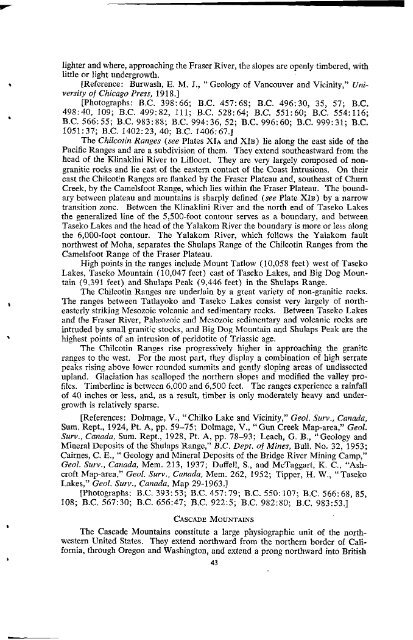Landforms of British Columbia 1976 - Department of Geography
Landforms of British Columbia 1976 - Department of Geography
Landforms of British Columbia 1976 - Department of Geography
Create successful ePaper yourself
Turn your PDF publications into a flip-book with our unique Google optimized e-Paper software.
.<br />
lighter and where, approaching the Fraser River, the slopes are openly timbered, with<br />
little or light undergrowth.<br />
[Reference: Burwash, E, M. J., “ Geology <strong>of</strong> Vancouver and Vicinity,” Uni-<br />
versity oj Chicago Press, 19 18 .]<br />
[Photographs: B.C. 398:66; B.C. 457:68; B.C. 496: 30, 35, 5’7; B.C.<br />
498: 40, 109; B.C. 499: 82, 111; B.C. 528: 64; B.C. 551: 60; B.C. 554: 116;<br />
B.C. 566: 55; B.C. 983: 88; B.C. 994: 36, 52; B.C. 996: 60; B.C. 999:31; B.C.<br />
1051: 37; B.C. 1402: 23, 40; B.C. 1406: 67.1<br />
The Chikotin Ranges (see Plates XIA and XIB) lie along the east side <strong>of</strong> the<br />
Pacific Ranges and are a subdivision <strong>of</strong> them. They extend southeastward from the<br />
head <strong>of</strong> the Khnaklini River to Lillooet. They are very largely composed <strong>of</strong> non-<br />
granitic rocks and lie east <strong>of</strong> the eastern contact <strong>of</strong> the Coast Intrusions. On their<br />
east the Chilcotin Ranges are flanked by the Fraser Plateau and, southeast <strong>of</strong> Chum<br />
Creek, by the Camelsfoot Range, which lies within the Fraser Plateau. The bound-<br />
ary between plateau and mountains is sharply defined (see Plate XIB) by a narrow<br />
transition zone. Between the Klinaklini River and the north end <strong>of</strong> Taseko Lakes<br />
the generalized line <strong>of</strong> the 5,500-foot contour serves as a boundary, and between<br />
Taseko Lakes and the head <strong>of</strong> the Yalakom River the boundary is more or less along<br />
the 6,000-foot contour. The Yalakom River, which follows the Yalakom fault<br />
northwest <strong>of</strong> Moha, separates the Shulaps Range <strong>of</strong> the Chilcotin Ranges from the<br />
Camelsfoot Range <strong>of</strong> the Fraser Plateau.<br />
High points in the ranges include Mount Tatlow (10,058 feet) west <strong>of</strong> Taseko<br />
Lakes, Taseko Mountain (10,047 feet) east <strong>of</strong> Taseko Lakes, and Big Dog Moun-<br />
tain (9,391 feet) and Shulaps Peak (9,446 feet) in the Shulaps Range.<br />
The Chilcotin Ranges are underlain by a great variety <strong>of</strong> non-granitic rocks.<br />
The ranges between Tatlayoko and Taseko Lakes consist very largely <strong>of</strong> north-<br />
easterly striking Mesozoic volcanic and sedimentary rocks. Between Taseko Lakes<br />
and the Fraser River, Paleozoic and Mesozoic sedimentary and volcanic rocks are<br />
intruded by small granitic stocks, and Big Dog Mountain and Shulaps Peak are the<br />
highest points <strong>of</strong> an intrusion <strong>of</strong> peridotite <strong>of</strong> Triassic age,<br />
The Chilcotin Ranges rise progressively higher in approaching the granite<br />
ranges to the west. For the most part, they display a combination <strong>of</strong> high serrate<br />
peaks rising above lower rounded summits and gently sloping areas <strong>of</strong> undissected<br />
upland. Glaciation has scalloped the northern slopes and modified the valley pro-<br />
files. Timberline is between 6,000 and 6,500 feet. The ranges experience a rainfall<br />
<strong>of</strong> 40 inches or less, and, as a result, timber is only moderately heavy and under-<br />
growth is relatively sparse.<br />
[References: DoImage, V., “ Chilko Lake and Vicinity,” Geol. Surv., Canada,<br />
Sum. Rept., 1924, Pt. A, pp. 59-75; Dolmage, V., “Gun Creek Map-area,” GeoZ.<br />
&rv., Canada, Sum. Rept., 1928, Pt. A, pp. 78-93; Leach, G. B., “Geology and<br />
Mineral Deposits <strong>of</strong> the Shulaps Range,” B.C. Dept. <strong>of</strong> Mines, Bull. No, 32, 1953;<br />
Cairnes, C. E., “ Geology and Mineral Deposits <strong>of</strong> the Bridge River Mining Camp,”<br />
GeoZ. Surv., Canuda, Mem. 213, 1937; Duffell, S., and McTaggart, K. C., “Ash-<br />
cr<strong>of</strong>t Map-area,” Geol. Surv., Canuda, Mem. 262, 1952; Tipper, H. W., “ Taseko<br />
Lakes,” Geol. Surv., Canada, Map 29-1963.1<br />
[Photographs: B.C. 393: 53; B.C. 457: 79; B.C. 550: 107; B.C. 566: 68, 85,<br />
108; B.C. 567:30; B.C. 656:47; B.C. 922:5; B.C. 982:80; B.C. 983:53.]<br />
CASCADE MOUNTAINS<br />
The Cascade Mountains constitute a large physiographic unit <strong>of</strong> the north-<br />
western United States. They extend northward from the northern border <strong>of</strong> Cali-<br />
fornia, through Oregon and Washington, and extend a prong northward into <strong>British</strong><br />
43











